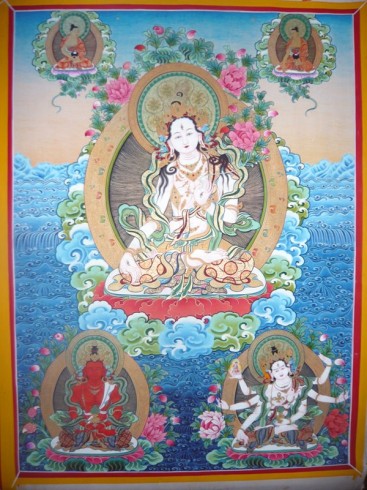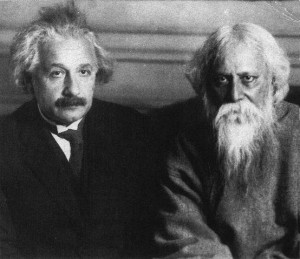Search results for patanjali (49)
YOGA SUTRAS OF PATANJALI
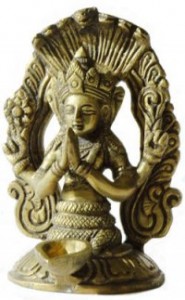
> The Yoga Sutras Of Patanjali <
> P A T A N J A L I, Full Aspects <
Patanjali was a great sage that lived thousands of years ago. The yoga Sutras he wrote seem to have transcended time remaining one of the most influential spiritual writings in Yoga.
The Yoga Sutras consist of 195 verses divided into 4 chapters. It is a book for those who have already practiced some meditation and attained some higher states of consciousness.
The Yoga Sutras of Patanjali is a foundational text of Yoga. It forms part of the corpus of Sutra literature dating to India’s Mauryan period. In Indian philosophy, Yoga (also Raja Yoga to distinguish it from later schools) is the name of one of the six orthodox philosophical schools.Though brief, the Yoga Sutras are an enormously influential work on yoga philosophy and practice, held by principal proponents of yoga such as > Iyengar < (1993: p.xiii) as being of principal importance:
Patañjali fills each sutra with his experiential intelligence, stretching it like a thread (sūtra), and weaving it into a garland of pearls of wisdom to flavour and savour by those who love and live in yoga….
Read More: > here <
Mantra of sage Patanjali:
- yogena chittasya padena vacham malam sarirasya cha vaidyakena | yopakaroti tam pravaram muninam patanjalim pranajaliranato’smi ||
- Let us bow the noblest of sages Patanjali, who gave Yoga for serenity of the mind, Sanskrit grammar for purity of speech and Ayurvedic medicine for the perfection of health.
PATANJALI – DIE WURZELN DES YOGA
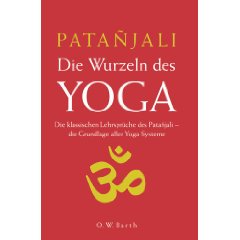
Die klassischen Lehrsprüche des Patanjali
von Bettina Bäumer
> YOGA & AYURVEDA von Vinod Verma <
Patanjalis Yoga-Sutras und ihre Anwendung auf Ayurveda
Patanjali (Sanskrit, पतञ्जलि, Patañjali, [pʌtʌɲʤʌlɪ]) war ein indischer Gelehrter, der die heute noch vollständig überlieferten Yoga-Sutras verfasst haben soll. In der indischen Mytholgie gilt er als Inkarnation des Schlangenkönigs Shesha. Über das Leben von Patañjali ist jedoch nichts bekannt, auch nicht wann er gelebt hat. Es ist nicht einmal sicher, ob er eine historische Persönlichkeit war. Indische Tradition setzt ihn mit dem Grammatiker gleichen Namens, der im 2. Jahrhundert vor Christus lebte, gleich. Da der Wortschatz des Grammatikers und des Schreibers jedoch stark von einander abweichen, gehen Indologen davon aus, dass es sich nicht um die gleiche Person handelt. Vielmehr sind sie aufgrund bestimmter Formulierungen, die sich auch im Spätbuddhismus finden, der Ansicht, das Werk sei im 4. oder 5. Jahrhundert nach Christus entstanden.
Wörtlich übersetzt bedeutet Sutra „Faden“. Das Yoga-Sutra ist also gewissermaßen ein Leitfaden für Yoga, der anders als die Bhagavadgita keine Rahmenhandlung besitzt und auch nicht gesungen wurde. Das Yoga-Sutra von Patañjali besteht aus 195 Sanskrit-Versen, in denen in hochkonzentrierter Form die Essenz des Yoga-Weges gebündelt ist. Es ist eine der ältesten Überlieferungen der Yoga-Tradition. Diese Form des Yoga wird als Raja Yoga oder Ashtanga Yoga (achtgliedriger Yoga) bezeichnet.
Kurzbeschreibung
Diese klassischen Lehrsprüche bilden die geistige Grundlage aller Yogasysteme. Sie stammen aus Überlieferungen, die wahrscheinlich im 2. Jahrhundert v. Chr. von Patañjali aufgezeichnet wurden. Die Vielfalt der Schulen und Richtungen, die sich im Laufe der Jahrhunderte entwickelt haben, geht auf diese älteste Quelle zurück. Die 195 prägnanten Sentenzen weisen den »königlichen Weg« zur vollkommenen inneren Befreiung durch rechte Erkenntnis. Er führt schrittweise , ohne Askese und gewaltsame Unterdrückung der Denkvorgänge, zum Verständnis der Wirklichkeit. Im Yoga leben heißt, unmittelbar, von Augenblick zu Augenblick, ohne hemmende Bindung an die Vergangenheit, ohne eingeschliffene Gewohnheiten oder eine überkommene Weltanschauung leben. P.Y. Deshpande, ein bekannter Schriftsteller und Publizist, hat sich über vierzig Jahre lang in Theorie und Praxis mit Yoga beschäftigt. Seine Einsichten, die Früchte dieser langjährigen Erfahrung, bilden zusammen mit den von Bettina Bäumer aus dem Sanskrit übertragenen Sutren ein unentbehrliches Standardwerk auf dem Gebiet des Yoga.
Patanjali International Yoga Foundation®
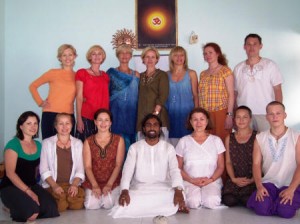
> Patanjali International Yoga Foundation <
„The Basic Principle of our foundation-Truth to the Original Source. We follow the Ancient Yoga Style taken from Sanskrit books“
Mantra of sage Patanjali:
- yogena chittasya padena vacham malam sarirasya cha vaidyakena | yopakaroti tam pravaram muninam patanjalim pranajaliranato’smi ||
- Let us bow the noblest of sages Patanjali, who gave Yoga for serenity of the mind, Sanskrit grammar for purity of speech and Ayurvedic medicine for the perfection of health.
The system of Patanjali Yoga is loyal to the original source taken from the Ancient Sanskrit books.
Yoga Style includes: physical asana, pranayama, bandha, mudra, kriya, chakra and various meditation techniques, as described in the ancient scriptures of the sage Patanjali…
The training program includes Yoga Teachers Training Course (YTTC) 200/500hrs, Yoga-Ayurveda Therapy Course (YATC) 200hrs, intensive one month course, seminars, workshops and retreats. Participation and meeting the course requirements entitles the student with certificate recognized and registered with state government of India.
{„YTTC and YATC“ both courses are suitable for all level of serious yoga students. These courses are not only for teacher or who wants to be a yoga teacher but also suitable for those students who wants to experience of yoga practice, yoga retreats, yoga benefits, health through yoga, correct learning and deep information about yoga.}
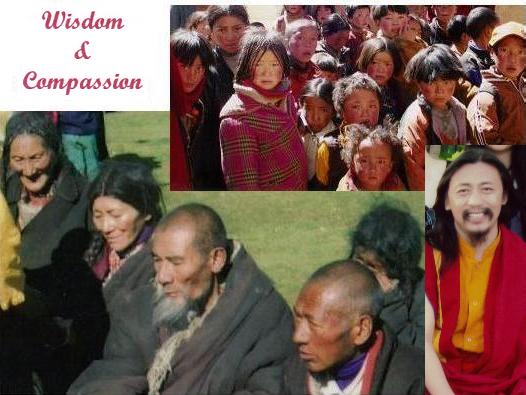
Freedom of Religion & Belief – China: Tibetan Monasteries Placed Under Direct Rule
Tibetan Yoga Center – Yoga Retreats
Contact: tibetanyogainfo@gmail.com
www.bhutanzopa.com.bt/AdventureTravel
The practice of Yoga is intimately connected to the religious beliefs and practices of both Buddhism and Hinduism. However there are distinct variations in the usage of yoga terminology in the two religions. In Hinduism, the term „Yoga“ commonly refers to the eight limbs of yoga as defined in the Yoga Sutras of Patanjali, written some time after 100 BCE, and means „yoke“, with the idea that one’s individual atman, or soul, would yoke or bind with the monistic entity which underlies everything (brahman). In the Vajrayana Buddhism of Tibet, however, the term „Yoga“ is simply used to refer to any type of spiritual practice; from the various types of tantra (like Kriyayoga or Charyayoga) to ‚Deity yoga‘ and ‚guru yoga‘. In the early translation phase of the Sutrayana and Tantrayana from India, China and other regions to Tibet, along with the practice lineages of sadhana, codified in the Nyingmapa canon, the most subtle ‚conveyance‘ (Sanskrit: yana) is Adi Yoga (Sanskrit). A contemporary scholar with a focus on Tibetan Buddhism, Robert Thurman writes that Patanjali was influenced by the success of the Buddhist monastic system to formulate his own matrix for the version of thought he considered orthodox. Read More: HERE
Early Buddhism incorporated meditative absorption states. The most ancient sustained expression of yogic ideas is found in the early sermons of the Buddha. One key innovative teaching of the Buddha was that meditative absorption must be combined with liberating cognition. The difference between the Buddha’s teaching and the yoga presented in early Brahminic texts is striking. Meditative states alone are not an end, for according to the Buddha, even the highest meditative state is not liberating. Instead of attaining a complete cessation of thought, some sort of mental activity must take place: a liberating cognition, based on the practice of mindful awareness. The Buddha also departed from earlier yogic thought in discarding the early Brahminic notion of liberation at death. Liberation for the Brahminic yogin was thought to be the realization at death of a nondual meditative state anticipated in life. In fact, old Brahminic metaphors for the liberation at death of the yogic adept were given a new meaning by the Buddha; their point of reference became the sage who is liberated in life. Read More: HERE
Dream Yoga or Milam (T:rmi-lam or nyilam; S:svapnadarśana)— the Yoga of the Dream State are a suite of advanced tantric sadhana of the entwined Mantrayana lineages of Dzogchen (Nyingmapa, Ngagpa, Mahasiddha, Kagyu and Bönpo). Dream Yoga are tantric processes and techniques within the trance Bardos of Dream and Sleep (Tibetan: mi-lam bardo) and are advanced practices of Yoga Nidra. Aspects of Dream Yoga sadhana are subsumed within the practice suite of the Six Yogas of Naropa. Read More: > HERE <
Tibetan yoga center was established to provide a program of study and practice in the Tibetan Buddhist (Vajrayana) tradition that would integrate the essence of these teachings and present them in a suitable way for practitioners in the West. The program combines the core practices relying on visualizations, yoga of channels, winds and drops, and insight into the nature of the mind (rigpa) for efficient progress on the path. The core teachings of Tibetan Yoga Center are ‚The yogas of the six bardos‘ of the Nyingma lineage of Tibetan Buddhism, summarized in the curriculum as seven courses (see the program section). The founder and master teacher of the center, Khenchen Lama Rinpoche, was at numerous occasions encouraged by his teachers to focus on helping Western students, particularly through these practices. To help bring these teachings closer to the background of Western practitioners, the program of the Tibetan Yoga Center also integrates elements of Western neuroscientific research on changes in behavior, mind and brain as a result of meditation. Building on the tradition of enlightened householder yogis in Tibet, the program of the center was developed for yogis of the current era – serious practitioners leading busy lives with work and family commitments who want to bring their spiritual practice to swift fruition to fully benefit sentient beings.
Tibetan Yoga Center operates on principles of a social business, offering teachings mostly by suggested donation and for minimal possible fees to cover expenses. The aim of the Tibetan yoga of mind is to develop universal loving kindness and compassion coupled with the ultimate wisdom of the nature of phenomena, the ultimate truth. At the basic level of achievement, one wishes happiness for oneself as well as other people.
At the medium level of achievement one realizes that the source of ultimate happiness is the understanding of the true nature of phenomena. One realizes that the most profound way to benefit sentient beings is to achieve enlightenment and works very hard towards this goal. On this path, one completely purifies his/her mental afflictions – anger, attachment, ignorance, jealousy and pride. The highest level of achievement in the Tibetan yoga of mind is the experiential understanding of our own Buddha nature – the deepest level of the mind. When one continuously sustains this realization in his/her mind stream, s/he becomes the embodiment of the union of primordial wisdom and compassion, and benefits sentient beings in limitless ways. This achievement is the essence of the Tibetan yoga and the deepest meaning of the term ’naljor‘.
TYPES OF YOGA IN TIBETAN BUDDHISM – There are six yanas (modes of spiritual practice) in Vajrayana: 1. Kriyayana, 2. Upayana, 3. Yogayana, 4. Mahayoga, 5. Anuyoga, and 6. Atiyoga. In Nyingma lineage, the main focus of practice is on Mahayoga, Anuyoga and Atiyoga.
Teaching and Practice Downloads: This section contains general teachings given by teachers of the Tibetan Yoga Center at various occasions as well as specific teachings that are part of the curriculum of the center. These teachings are available for free, but proper reference to the teachings if used as part of other materials should be included.
Previous some related #articles #videos:
Mountain Minorities and Indigenous Peoples
Yoga of Himalayas – Nuns & Communities
The Ninth Mandaean Camp Niagara Falls
UNESCO – The Tradition of Vedic Chanting
UN – Nagoya biopiracy agreement ‚is unexpected success‘
Saving the Bedouin Heritage and Biodiversity
A Call for Renewable Energy in Brazil – Belo Monte
Indigenous Australien Medicine – Bush Medicine
Build Hope – Sivananda Sevashram
ARGAN TREE – Argan Oil Morocco
Jain Tradition – Mahavir Jayanti India
Monasteries Environmental Himalayaprotection
Monks lead march to save Himalayas
Interfaith Center: Gala Dinner with Yusuf Islam
Gilgit (UNESCO Gilgit Manuscripts) Baltistan – National Conference Sufism
Bahá’í – Religion für eine neue Zeit
Introduction – Swami Vivekananda – Jnana Yoga
The Hindu approach to spiritual evolution leading to liberation or moksha or Self-realization is one of the four major paths or yogas:
-
the path of knowledge or Jnana yoga,
-
the path of mind control or Raja Yoga ,
-
the path of devotion of Bhakti yoga and
-
the path of action/work or Karma yoga.
#video Swami Vivekananda 1893 Speech at Parliament of Religions Part 1 of 4
Swami Vivekananda was the chief disciple of the 19th century saint Ramakrishna Paramahansa and the founder of the Ramakrishna Math and the Ramakrishna Mission. He is considered a key figure in the introduction of Indian philosophies of Vedanta and Yoga to the „Western“ world, mainly in America and Europe and is also credited with raising interfaith awareness, bringing Hinduism to the status of a major world religion during the end of the 19th century CE. Vivekananda is considered to be a major force in the revival of Hinduism in modern India.
He is perhaps best known for his inspiring speech which began: „Sisters and Brothers of America,“ through which he introduced Hinduism at the Parliament of the World’s Religions in Chicago in 1893.
The Council for a Parliament of the World’s Religions works to cultivate harmony among the world’s religious and spiritual communities to achieve a just, peaceful and sustainable world.
The first Parliament of Religions was held at the 1893 Chicago Columbian Exposition, and was the first formal meeting of the religious East and West. In 1988 the Council for a Parliament of the World’s Religions (CPWR) was founded to organize a centennial celebration of the original Parliament. Since 1993, three Parliaments have been held in Chicago, Cape Town, Barcelona and in 2009 the most recent Parliament was held in Melbourne, Australia.
Dr. Joachim Reinelt: Zur Zeit des indischen Mittelalters wanderten in weiten Teilen Indiens und Tibets tantrische Mystiker umher, die Nathas, Nathayogis oder Nathasiddhas genannt wurden. Sie praktizierten und lehrten Hatha- und Kundaliniyoga und hatten großen Einfluss auf das religiöse Leben der Menschen.
Gorakshanatha Saivism: Gorakhnath or Gorakshanatha Saivism is also known as Siddha Siddhanta and Nath tradition. It was founded by Gorakshanatha (Gorakhnath) who lived about 10th century AD. He is believed to be 3rd, 4th or 5th in a line of 12 prominent teachers of this tradition, which has followers in both Buddhism and Hinduism.
He was said to be a disciple of Matsyendranatha who was from in Nepal. Followers of this sect believe that knowledge of this tradition was received by Matsyendranath directly from Siva himself. Gorakshanatha is credited with such works as Siddha Siddhanta Paddhathi and Viveka Martanda. He composed them in Hindi. He also created 12 monastic orders across Northern India in an effort to preserve the Adinatha tradition. Other important works of this tradition are Hathayoga Pradipika, Gheranda Samhita, Siva Samhita and Jnanamrita.
History of the Nathas – The history of ancient Indian sadhu texts reveals a succession of several main groups. There were the Sadhs, Yatis, Siddhas, Nathas, Pashupatis, Sant-Mats, Dasnamis and Nagas. Apart from these, many small sadhu sects have existed and played their part in the great stream of Indian life. In early history, it would appear that some sects were interwoven with others, and some merged or developed into other sects. Some thus became extinct, and others are still with us.
Full Article: http://www.saivism.net
http://www.facebook.com/parliamentofreligions
http://en.wikipedia.org/wiki/Swami_Vivekananda
Bhutan http://en.wikipedia.org/wiki/Gross_national_happiness
UN – The Challenge of Human Rights and Cultural Diversity
UNESCO – Intangible Cultural Heritage
UN – Nagoya biopiracy agreement ‚is unexpected success‘
http://www.twnside.org.sg/title2/books/The.Road.to.an.Anti-Biopiracy.Agreement.htm
Amnesty International – What are economic, social and cultural rights?
*************************************
China: Tibetan Monasteries Placed Under Direct Rule
(New York) – The Chinese government has ended a key policy of allowing Tibetan monasteries to be run by monks who comply with government regulations and have instead introduced a system that will place almost every monastery in Tibet under the direct rule of government officials who will be permanently stationed in each religious institution, Human Rights Watch said today.
The new system now requires an unelected „Management Committee“ – also referred to as zhusi danwei/gongzuozu („monastic government work-unit“)- to be established in every monastery, with up to 30 lay officials stationed in each monastery, depending on the size of the institution, according to a February 15, 2012 article in the government-run Global Times. The new „Management Committees“ will run the monasteries and will have authority over the previous „Democratic Management Committees,“ which will now be responsible for rituals and other matters.
The freedom to leave or discontinue membership in a religion or religious group —in religious terms called „apostasy“ —is also a fundamental part of religious freedom, covered by *Article 18 of the Universal Declaration of Human Rights.[2]
Freedom of religion is a principle that supports the freedom of an individual or community, in public or private, to manifest religion or belief in teaching, practice, worship, and observance; the concept is generally recognized also to include the freedom to change religion or not to follow any religion.[1]
#video Meeting with Special Rapporteur on Freedom of Religion or Belief, Heiner Bielefeldt As always saying something on the topic of freedom of religion or belief, to say it again, the most shocking experience when dealing with case of violations of freedom of religion is the extreme manifestation and degree of hatred “ http://www.youtube.com/watch?v=81qyyKzntJw
http://www.hreoc.gov.au/human_rights/religion/index.html
http://en.wikipedia.org/wiki/Freedom_of_religion
http://www.ohchr.org/EN/Issues/FreedomReligion/Pages/FreedomReligionIndex.aspx
February 29, 2012
Australian Broadcasting Corporation – Exiled PM wants ‚fact finding‘ mission in Tibet
March 3, 2012
UN Human Rights Chief asked when she would visit Tibet
Mar 6, 2012
UN calls on China to stop forced settlement of Tibetan Nomads
8 March 2012
“Unfinished progress” – UN expert examines food systems in emerging countries reports* on China, Mexico and South Africa to the Human Rights Council. In China, local-level authorities often have allowed land-grabbing at the expense of poor rural households. And between 50 and 80 per cent of the 2.25 million nomads on the Tibetan plateau may be relocated into settlements close to rural cities, overhauling the food and farming practices of this vulnerable community as part of a programme to abandon nomadic life and modernize agriculture. ( Latest Water UN Report – World Consumption of modern agriculture on fresh water by 70% )
chinadialogue Tibetan herders are struggling to adjust to sedentary life on the edge of the city of Golmud. Xia Liwei visited one family and listened to their story. http://www.chinadialogue.net/–Who-are-these-people-now
chinadialogue As China seeks to protect a delicate corner of Qinghai, 50,000 herders have been moved off the grasslands. Ill-prepared for urban life, they face a bleak future, write Guan Guixia and Suonan Wangjie. http://www.chinadialogue.net/–Hard-times-for-eco-migrants
TIBETAN NOMADS Tibetan herder with a yak Nomadic herders are known as drokpa. They make up about 25 percent of Tibetans in Tibet. In some Tibetan counties they make up 90 percent of the population. http://factsanddetails.com/china.tibetan nomads
IYENGAR YOGA & SAVE GANGA MOVEMENT
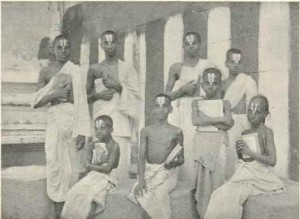
Iyengar Vedic Students 1909
The World’s First Sage Patanjali temple
„Health is firmness in body, stability in mind, and clarity in thinking. If a mirror is clean, it reflects objects clearly….health is the mirror of man.“ – B.K.S. Iyengar
Bellur Krishnamachar Sundararaja Iyengar (Kannada: ಬೆಳ್ಳೂರ್ ಕೃಷ್ಣಮಾಚಾರ್ ಸುಂದರರಾಜ ಐಯಂಗಾರ್, Tamil: பெல்லூர் கிருஷ்ணமாச்சார் சௌந்தரராஜா ஐயங்கார்), (generally known as Yogacharya B. K. S. Iyengar) (Born December 14, 1918 in Bellur, Kolar District, Karnataka, India) is the founder of Iyengar Yoga. He is considered one of the foremost yoga teachers in the world and has been practicing and teaching yoga for more than 75 years. He has written many books on yogic practice and philosophy, and is best known for his books Light on Yoga, Light on Pranayama, and Light on the Yoga Sutras of Patanjali. He has also written several definitive yoga texts. Iyengar yoga centers are located throughout the world, and it is believed that millions of students practice Iyengar Yoga.
He was awarded the Padma Shri in 1991, and the Padma Bhushan in 2002. In 2004, Iyengar was named one of the 100 most influential people in the world by Time Magazine. Read More: > HERE <
The Patanjala Yoga Kendra was established in 1993 on the banks of the Holy River Ganges in Rishikesh, the world capital of Yoga. The method of Yoga that is taught is Iyengar Yoga, as developed and taught by Shri Guruji, B.K.S. Iyengar, the world-famous Yoga Teacher. Guruji’s method is firmly based in the ancient Indian tradition of Yoga as defined in the Yoga Sutras of Patanjali. Usha Devi is the resident Yoga Instructor.
Iyengar Yoga teaches strength and stamina, flexibility and balance, concentration and meditation. Iyengar Yoga begins with physical awareness, but goes beyond to embrace emotional and spiritual growth. As students learn to extend consciousness to each part of their bodies, they experience a concentrated focus on the moment. In time, this concentrated focus (Pratyahara) becomes an integral part not just of a yoga practice, but of daily life.
Welcome to Save Ganga Movement – A Gandhian Non-violent Movement to Save the Ganga, symbolizing all rivers and water bodies and the Giriraj Himalayas, symbolizing all mountains, forests and wildlife. Gandhi symbolizes a culture of Truth and non-violence, i.e. a culture of pursuit of ethical perfection as the ultimate goal of life and pursuit of selfless ethical life of universal love as it’s means. The Surest and Perhaps the Only Solution to Our Impending Catastrophic Global Ecological Crises: Go Through Gandhi the Apostle of Truth and Non-violence of our Age.
- IYENGAR – BELLUR SCHOOL TRUST (BKSSNT)<
- Monasteries Environmental Himalayaprotection <
- SAVE MOTHER EARTH, SAVE GANGA & YAMUNA <
- Meet Iyengar Yoga, studies, friends, fans at fb <
- Meet Save Ganga Movement, friends at fb <
- Meet Save the Ganga (Ganges) River, friends at fb <
- Meet Save Yamuna to save Vrindavan! at fb <
- Meet M.K. Gandhi Institute for Nonviolence, studies, friends at fb <
CELEBRATION OF TAGORE´s 150th BIRTHDAY
TAGORE, Crisis in Civilization , There are Real Alternatives. A.E. Inst.
Rabindranath Tagore’s Birthday
Rabindranath Tagore (7 May 1861 – 7 August 1941), sobriquet Gurudev, was a Bengali polymath. As a poet, novelist, musician, and playwright, he reshaped Bengali literature and music in the late 19th and early 20th centuries. As author of Gitanjali and its „profoundly sensitive, fresh and beautiful verse“, in 1913 being the first non-European to win the Nobel Prize in Literature, Tagore was perhaps the most important literary figure of Bengali literature. He was a mesmerising representative of the Indian culture whose influence and popularity internationally perhaps could only be compared to that of Gandhi, whom Tagore named ‚Mahatma‘ out of his deep admiration for him. A Pirali Brahmin from Kolkata, Tagore was already writing poems at age eight.At age sixteen, he published his first substantial poetry under the pseudonym Bhanushingho („Sun Lion“) and wrote his first short stories and dramas in 1877. Tagore denounced the British Raj and supported independence. His efforts endure in his vast canon and in the institution he founded, Visva-Bharati University. Read More: > HERE <
Albert Eintstein Institute, About Our Name – Albert Einstein was deeply concerned about war, oppression, dictatorship, genocide, and nuclear weapons. He was willing to explore new approaches to confronting these problems of political violence, although he was not always happy with the choices available to him. At various times he was a war resister, a supporter of the war against the Nazi system, and an advocate of world government. In his later life, he became enormously impressed with the potential of nonviolent struggle. In 1950, he remarked on a United Nations radio broadcast that, „On the whole, I believe that Gandhi held the most enlightened views of all the political men in our time….“
Today, the Albert Einstein Institution continues work on that aspect of Einstein’s thought, examining the potential of nonviolent struggle to resolve the continuing problems of political violence.
Applications of Nonviolent Action (AHIMSA) – Nonviolent struggle can be used in a variety of circumstances for a variety of objectives. These include:
Dismantling dictatorships, Blocking coups d’état, Defending against foreign invasions and occupations, Providing alternatives to violence in extreme ethnic conflicts, Challenging unjust social and economic systems, Developing, preserving and extending democratic practices, human rights, civil liberties , and freedom of religion, Resisting genocide
More information can be found about each of these applications in the > publications section < of our web. site.
K. J. Yesudas (Carnatic Music) www.hrw.org
Yama, niyama, asana, pranayama, pratyahra, dharana, dhyana and samadhi are the eight limbs of yoga . Ahimsa, satya, asteya, bramacharya and aparigraha are the five yamas – The yoga sutras of Patanjali, 2.30-31
In the classical yoga system described by Patanjali more than two thousand years ago, the first stage (or limb, as they are generally called) of yoga is Yama (ethical disciplines) and of these, Ahimsa is the first. (The ethical Do´s and Don´ts or commandments for a propper way of life.)
In short, according to Patanjali, ahimasa, non-violence or, as Desikashar defines it, “Consideration for all living creatures, especially those who are innocent, in difficulty or worse off than we are” should be the very beginning of any yoga practice.
Sadhana : the realisation of life by Rabindranath Tagore Rabindranath Tagore (1861-1941) was a Bengali poet, philosopher, artist, playwright, composer and novelist. India’s first Nobel laureate, Tagore won the 1913 Nobel Prize for Literature. He composed the text of both India’s and Bangladesh’s respective national anthems. Tagore travelled widely and was friends with many notable 20th century figures such as William Butler Yeats, H.G. Wells, Ezra Pound, and Albert Einstein. While he supported Indian Independence, he often had tactical disagreements with Gandhi (at one point talking him out of a fast to the death). His body of literature is deeply sympathetic for the poor and upholds universal humanistic values. His poetry drew from traditional Vaisnava folk lyrics and was often deeply mystical.
Sadhana is a collection of essays, most of which he gave before the Harvard University, describing Indian beliefs, philosophy and culture from different viewpoints, often making comparison with Western thought and culture. (Summary by Peter Yearsley/Wikipedia)
CONTENTS: I. THE RELATION OF THE INDIVIDUAL TO THE UNIVERSE, II. SOUL CONSCIOUSNESS,III. THE PROBLEM OF EVIL, IV. THE PROBLEM OF SELF, V. REALISATION IN LOVE, VI. REALISATION IN ACTION, VII. THE REALISATION OF BEAUTY, VIII. THE REALISATION OF THE INFINITE
FULL TEXT AT PROJEKT Gutenberg < TAGORE AT SACRED TEXT´s < ( Gitanjali [1913], Saddhana, The Realisation of Life [1916] The Crescent Moon [1913], Fruit-Gathering [1916], Stray Birds [1916], The Home and the World [1915], Thought Relics [1921] Songs of Kabîr[1915])
Project Gutenberg, abbreviated as PG, is a volunteer effort to digitize and archive cultural works, to „encourage the creation and distribution of eBooks.“ Founded in 1971 by Michael S. Hart, it is the oldest digital library. www.gutenbergnews.org & www.gutenberg.org
- Tagore, Gandhi and India today <
- VISVA-BHARATI , RABINDRANATH TAGORE – YOGAH ,SCIENCE, POETRY <
- Vedanta, Quantum Physics & Erwin Schrödinger <
- AHIMSA IN YOGA, MUSIC AND SPIRITUALITY <
- The Universal Declaration of Human Rights < , United Nations: Human Rights <
- Meet Human Rights Watch, friends at fb <
- Meet Project Gutenberg, Online Library , studies, friends at fb <
- M.K. Gandhi Institute for Nonviolence, studies, friends at fb <
- Meet The Nobel Women’s Initiative, studies, friends at fb <
- Meet Council for a Parliament of the World’s Religions (CPWR), friends, fans at fb <
AHIMSA IN YOGA, MUSIC AND SPIRITUALITY
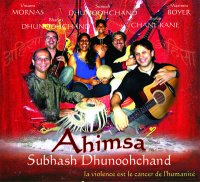
> Presentacion para la reunion de lanzamiento del proyecto <
> Free Streaming, Music Downloads, etc… <
> Tabla classique à La Réunion <
Ahimsa (Sanskrit: Devanagari; अहिंसा; IAST ahiṃsÄ�, PÄ�li: avihiṃsÄ�) is a term meaning to do no harm (literally: the avoidance of violence – himsa). It is an important tenet of the religions that originated in ancient India (Hinduism, Buddhism and especially Jainism).
Ahimsa is a rule of conduct that bars the killing or injuring of living beings. It is closely connected with the notion that all kinds of violence entail negative karmic consequences. The extent to which the principle of non-violence can or should be applied to different life forms is controversial between various authorities, movements and currents within the three religions and has been a matter of debate for thousands of years. Though the origins of the concept of ahinsa are unknown, the earliest references to ahinsa are found in the texts of historical Vedic religion, dated to 8th century BCE. Here, ahinsa initially relates to „non-injury“ without a moral connotation, but later to non-violence to animals and then, to all beings. Though meat-eating and slaughter of animals are criticized by some Hindu texts, other texts present counter-arguments in support of ritual sacrifice. In the 19th and 20th centuries, prominent figures of Indian spirituality such as Swami Vivekananda, Ramana Maharishi, Swami Sivananda and A. C. Bhaktivedanta Swami Prabhupada emphasized the importance of ahinsa. Mahatma Gandhi applied ahinsa to politics, by his non-violent satyagrahas. Read More: > HERE <
One of French’s most innovative sound artists, Subhash Dhunoohchand’s consistently challenging albums and live performances have been central to the continued rise of Indian-influenced fusion music. A pivotal figure in Reunion Island, France he has pursued his own audio explorations with his new project TABLATRONIC.
Here, the dates of our next concerts in Reunion Island:
- 7 Avril 2010, Le Mag TéléRéunion, AHIMSA et YATRA
- 9 Avril 2010, salle guy alphonsine YATRA musique live et danse indienne (kathak, bharatanatyam, odissie)
- 10 Avril 2010, Show Case Hyper U Bel Air St Louis, 15H à 18H, Tablatronic et Ahimsa
- 14 Avril 2010, probablement dans l’Est…
- 16 Avril 2010, probablement dans le Sud…
- 17 Avril 2010, probablement dans le Nord-Est…
- Keep in Touch !
Born in Mauritius of Indian parents he is the 4th generation in the island call the paradise of the Indian Ocean. Subhash Dhunoohchand was inspired by his father, late Balram Dhunoohchand to learn the precision beats of the tabla, which he began playing when he was 17. Later he went to India for further classical training as a student of Pandit Sudhir Kumar Saxena. He ha s been working with such diverse musicians as Pt Hariprasad Chaurasia, Pt Budhaditya Mukherjee, Rupak Kulkarni, Rakesh Chaurasia, Sazed Ul Alam, Trilok Gurtu and many well known jazz musicians like Ola Melander, Anatholi Bulkin, Xavier Rudd and Lars Gullikson.
Subhash Dhunoohchand is the disciple of Pt S.K. Saxena and has played with great musician like, Pt .Chaurasia, Pt B. Mukherjee, Trilok Gurtu, Susheela Raman, Xavier Rudd etc….// Fusion of Indian, African & Reunion Music. La rencontre de la musique indienne, africaine & réunionnaise.
In the mid-90s Subhash founded Cosmic Sound, an indo jazz fusion music group. In 1993 he release his first CD, Raga Marwa of Indian Classical Music in Sweden with Sazed Ul Alam and at the same time performing with the jazz fusion music group. His groundbreaking debut release Obsession, was recorded in France, and featured contributions from Anupriya Deotale, late Soudama Jankee, Anatholi Bulkin, Celine Bonacina and Rupak Kulkarni. An astonishing marriage of traditional Indian sounds and jazz, it deservedly received strong reviews.
For this European tour Subhash is travelling with his son Sumesh on tabla, Bharati on vocal, Bruno Chane Kane on electric guitar from France and Nandkumar on bass tabla. We are also performing with some indian music musicians from London. A dedicated fusionist with both an uncanny ear for melody and an innate talent for complex rhythms, Subhash Dhunoohchand always seems to be one step ahead of his electronic.
Yama, niyama, asana, pranayama, pratyahra, dharana, dhyana and samadhi are the eight limbs of yoga . Ahimsa, satya, asteya, bramacharya and aparigraha are the five yamas – The yoga sutras of Patanjali, 2.30-31
In the classical yoga system described by Patanjali more than two thousand years ago, the first stage (or limb, as they are generally called) of yoga is Yama (ethical disciplines) and of these, Ahimsa is the first.
In short, according to Patanjali, ahimasa, non-violence or, as Desikashar defines it, „Consideration for all living creatures, especially those who are innocent, in difficulty or worse off than we are“ should be the very beginning of any yoga practice.
- www.gandhiinstitute.org
- www.bansuriflute.com
- VEDIC BOOKS: THE ART OF TABLA RYTHM <
- TRADITIONAL MUSIC INSTRUMENTS, Sound & Yoga <
- YAMA AND NIYAMA <
- Meet Hariprasad Chaurasia, studies, friends, fans at fb <
- Meet Prasad Bhandarkar´s, studies, friends, fans at fb <
- Meet Sheela Bringi, studies, friends, fans at fb <
- Meet Subhash fans club at facebook <
- Meet AHIMSA Nonviolence , friends , fans at fb <
- Meet Ghandi Institute of Nonviolence, friends, fans at fb <
Yoga & Buddhism: Similarities & Differences
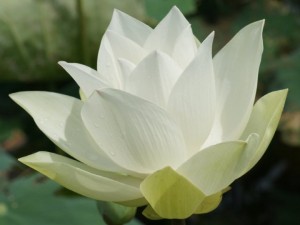
> TYS – Hindu, Buddhist, Jaina Yoga <
Yoga (Sanskrit, PÄ�li: योग yóga) refers to traditional physical and mental disciplines originating in India. The word is associated with meditative practices in Hinduism, Buddhism and Jainism. In Hinduism, it also refers to one of the six orthodox (Ä�stika) schools of Hindu philosophy, and to the goal toward which that school directs its practices. In Jainism it refers to the sum total of all activities—mental, verbal and physical.
Major branches of yoga in Hindu philosophy include Raja Yoga, Karma Yoga, Jnana Yoga, Bhakti Yoga, and Hatha Yoga.Raja Yoga, compiled in the Yoga Sutras of Patanjali, and known simply as yoga in the context of Hindu philosophy, is part of the Samkhya tradition. Many other Hindu texts discuss aspects of yoga, including Upanishads, the Bhagavad Gita, the Hatha Yoga Pradipika, the Shiva Samhita and various Tantras. Read More: > HERE <
Yoga and Buddhism: Similarities and Differences
Written by Dr. David Frawley
Yoga and Buddhism are sister traditions which evolved in the same spiritual culture of ancient India. They use many of the same terms and follow many of the same principles and practices. For this reason it is not surprising that many of us born in the West, particularly after an initial exposure, are apt to regard Yoga and Buddhist teachings as almost identical.
We may want to combine their teachings or practices accordingly, as if there were no real differences between them. The differences that have existed between the two systems historically, which have kept them apart as separate traditions, are less obvious to us in the West than are their commonalities. Or those who study one of these traditions may be inclined to see the other as a borrowing from it. Those who study Buddhism may find so much similarity in Yoga that they suspect a strong Buddhist influence on Yoga. Those who study Yoga may find so much similarity in Buddhism that they see a strong yogic influence on Buddhism.
However, the tendency to find commonality between these two great spiritual traditions is not limited to the West. Swami Vivekananda, the first great figure to bring Yoga to the West, examined the Buddhist Mahayana scriptures (Sutras) and found their key teachings and those of Vedanta that he followed to be ultimately in harmony. In recent years with the influx of Tibetan refugees into India, including the Dalai Lama, there has been a new dialogue between the two traditions that is bringing about greater respect between them. Tibetan Buddhists often appear at Hindu religious gatherings and partake in all manner of discussions.
Nor is the attempt to connect the two traditions limited to modern times. Various synthetic Hindu-Buddhist teachings have existed through history. Buddha himself was born a Hindu and some scholars have argued that Buddhism as a religion apart from Hinduism did not arise until long after the Buddha had passed away. A Shiva-Buddha teaching existed in Indonesia in medieval times, and for many Tantric Yogis it is difficult to tell whether they were Hindus or Buddhists. Buddha became accepted as an avatar of Vishnu for the Hindus during the medieval period, and most Hindus still consider that we live in the age of the Buddha-avatar. Most Hindus accept Buddha as a great teacher, even if they do not accept all Buddhist teachings. Full Article: > HERE <
- Meet Buddhism studies, groups, friends, at fb <
- Meet Hinduism studies, groups, friends, at fb <
- Meet Jainism studies, friends, fans, at fb <
- Meet Dr. David Frawley, AIVS, studies, friends, at fb <
- Meet Traditional Yoga Studies, friends at fb <
Researches in Indian and Buddhist Philosphy
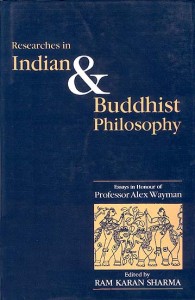
> Chap16: Comp. Siddis in Bhagavata Purana & Patanjali Yoga Sutras <
> BOOK: SIDDHIS IN THE BHAGAVAD PURANA <
Siddhi (Devnagari सिद्धि) is a Sanskrit noun that can be translated as „perfection“, „accomplishment“, „attainment“, or „success“. The term is first attested in the Mahabharata. In the Pancatantra, a siddhi may be any unusual skill or faculty or capability. As a legal term in the Manusmriti, it refers to the settlement of a debt.
In the Samkhya Karika and Tattva Samasa, and hence in Tantric Buddhism, it specifically refers to the acquisition of supernatural powers by magical means or the supposed faculty so acquired. These powers include items such as clairvoyance, levitation, to be present at various different places simultaneously, to become as small as an atom, to materialize objects, to have access to memories from past lives, etc. The term is also used in this sense in the Sarvadarsana-samgraha of Madhvacharya. Read More: > HERE <
Researches in Indian and Buddhist philosophy:
Essays in honour of Professor Alex Wayman, RÄ�ma Karaṇa ŚarmÄ�
The present volume, comprising ninteen articles by renowned scholars, is divided into three sections, namely, Buddhist Jaina and Hindu Philsosphical Researches. The articles in Hindu section take a comperative base. K.K.Raj compares the Buddhist and Mimamsa views on Laksana. K. Bhattacharya speaks of grammarians and philososphers regarding post-Panini grammarians on a certain anusasana. R.C.Dwivedi compares kashmir Saivism with Sankara`s Vedanta and T.S.Rukmani compares Siddhis as found in the Bhagavata Purana and in Patanjali`s Yogasutras. R.V. Joshi compares the Advaita and the Vaisnava views of the matter.
The present volume, comprising nineteen articles by renowned scholars, is divided into three sections, namely, Buddhist, Jaina and Hindu Philosophical Researches.
Under the Buddhist section Bareau, using the Vinaya in Chinese, defends Wayman’s position that Asanga belonged to Mahisasaka sect. Nakamura points out differing view about the seven Vajjian Republic principles. Michael Hahn and Samtani concern with Buddhist poet Candragomin and the term raga resectively. Shinjo Kawasaki expounds the views of Bhavya about the differing karma of non-sentient and sentient beings. Hirakawa’s article deals with the relation with dhatu. Collett Cox shows that the present 12-membered formula is taken for granted by early Chinese Abhidharma texts.
In Jaina section, Jaini deals with the theory that an omniscient being can subsist on a subtle kind of food. Dhaky’s main object t ascertain early parts of Dasavaikalikasutra, also goes into the matter of food.
The articles in Hindu section take a comparative base, K.K. Raja compares the Buddhist and Mimamsa views on Laksana. K. Bhattacharya speaks of grammarians and philosophers regarding post-Panini grammarians on a certain anusasana. R.C. Dwivedi compares Kashmir Saivism with Sankara’s Vedanta and T.S. Rukmani compares siddhis as found in the Bhagavata Purana and in Patanjali’s Yogasutras. R.V. Joshi compares the Advaita and the Vaisnava views of the matter.
The work breaks new grounds and is a solid contribution in the field of Indian Philosophy.
About the Author – Prof. R.K. Sharma as a Fulbright Scholar, worked with Prof. M.B. Emeneau at University of California. He has all along been contributing to promotion of Sanskrit Studies in India and abroad as Founder Director, Rashtriya Sanskrit Sansthan, Joint Educational Adviser, Govt. of India, Vice-Chancellor of the two Sanskrit Universities at Darbhanga and Varanasi, Visiting Professor at Columbia University of New York City, University of Bihar and Chicago, Organizing Secretary of two world Sanskrit Conferences, etc. He is a recipient of Presidential Award of Honour in Sanskrit and a Fellow of the Royal Asiatic Society.
Yogis in Tibet
Instructions On Siddhis
1. By the process of Hatha Yoga, the Yogi attains perfect physical body—Rupalavanya Bala Vajrasam-hanana Kaya Sampat. “The perfection of the body consists in beauty, grace, strength and adamantine hardness.” The power to bear extreme cold and heat (Titiksha), the power to live without water and food and other powers come under the category of Kaya Sampat (perfection of body).
2. Since the body of the Hatha Yogi is perfect and firm, his mind also is firm and one-pointed. By the practices of Dharana and Dhyana, he reaches the highest rung in the Yogic ladder and attains Immortality through Yogic Samadhi. The Yogi who has reached the highest stage, will have the 8 major and all the minor Siddhis.
3. Attainment of powers depends upon the amount of concentration at different Chakras and Tattvas and awakening of Kundalini. The practice of Mudras, Bandhas, Asanas and Pranayamas will also help a lot in acquiring Siddhis.
4. The Siddhis that are obtained by the practice of Mudras can be obtained by the practice of Bandhas, Asanas, Pranayamas and also by the concentration on different Chakras. That depends upon the temperament and capacity of the aspirants. One can obtain the desired goal by one exercise and others by different methods. Therefore if one is not able to get success by a particular exercise, he will have to have recourse to other exercises.
5. Many of the 8 major Siddhis are not possible at all at the present age (Kali Yuga), when the body and mind of the vast majority are not fit enough. Even today there are several Siddhas who have the power to perform some of the Siddhis. When people approach them to do this and that, they hide themselves or generally say:—“I do not know.” They are not much particular about these Siddhis. Their aim is to ignore these as unreal and aspire to reach the highest. They are the only real Yogins. Many are able to use some powers and they do not know how they are able to do them.
6. One can read the thoughts of others. A man in London hears the spiritual message of sages in India. You have seen several persons removing the poison of cobras by chanting some Mantras or by mere touch. By giving some sort of leaves, incurable diseases are cured. There are men who will very accurately tell your past, present and future. Some are able to see astral entities. Stopping the functions of the heart and changing the mind of others and other powers are due to Yogic practices.
7. Nowadays you cannot find a man who has developed all the powers. When one gets certain powers, he stops there by the influence of Maya and false Tushti (satisfaction) and uses the powers for his livelihood or for fame. Therefore he is not able to proceed further and attain perfection. It is not the mistake of the Yogic Kriyas. You should not lose faith. Faith, attention, sincerity and earnestness will lead you to success.
“ Of one thing we can be certain. The real Siddha who does not want or care for Siddhis, but who manifests Siddhis for unselfish reasons and as a result of communion with the Lord or the Brahman, is an entirely different person from the little man who has psychic powers to do things which are extraordinary or who has control of spirits. The power over spirits (good or bad) is entirely different from spiritual power. And no real Siddha goes about calling himself a Bhagavan or parading his powers. It cannot be said that the Siddha does not know that he performs miracles but they are not miracles to him—they are just ordinary things for him because he lives in the plane beyond the reach of the common man. I have to conclude that Swami Sivananda is one such. But he does not reveal himself as such to all and sundry.“ – Sri Swami Sivananda
- Also read from Kundalini Yoga- SRI SWAMI SIVANANDA
- KUNDALINI
- INTRODUCTION
- YOGA SADHANA
- PRANAYAMA
- PRAYER TO MOTHER KUNDALINI
- EXPERIENCES ON AWAKENING OF KUNDALINI
- GRADATIONAL ASCENT OF MIND
- PRANAYAMA FOR AWAKENING KUNDALINI
- ASANAS
- MUDRAS AND BANDHAS
- EIGHT MAJOR SIDDHIS
- DHARANA
- YOGA-KUNDALINI UPANISHAD
- Tibetan schools of Yoga:
- Anuyoga
- Mahayoga
- Six Yogas of Naropa
- Trul khor (Yantra Yoga)
UNESCO – The Tradition of Vedic Chanting
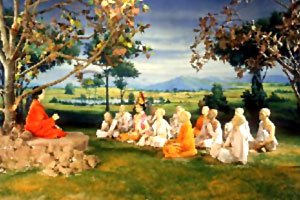
Shiksha is one of the six Vedangas
> UNESCO PUBLISHING, PURANAS & YOGA <
A shakha (Sanskrit śÄ�khÄ�, „branch“ or „limb“), is a Hindu theological school that specializes in learning certain Vedic texts, or else the traditional texts followed by such a school. An individual follower of a particular school or recension is called a śÄ�khin.- the term is also used in Hindu philosophy to refer to an adherent of a particular orthodox system.
A related term caraṇa, („conduct of life“ or „behavior“) is also used to refer to such a Vedic school : „although the words caraṇa and śÄ�khÄ� are sometimes used synonymously, yet caraṇa properly applies to the sect or collection of persons united in one school, and śÄ�khÄ� to the traditional text followed, as in the phrase śÄ�khÄ�m adhite, („he recites a particular version of the Veda“)“. The schools have different points of view, described as „difference of (Vedic) school“ (śÄ�khÄ�bhedaḥ). Each school would learn a specific Vedic Saṃhita (one of the „four Vedas“ properly so-called), as well as its associated Brahmana, Aranyakas, Shrautasutras, Grhyasutras and Upanishads. Read More: > HERE <
The Vedas comprise a vast corpus of Sanskrit poetry, philosophical dialogue, myth, and ritual incantations developed and composed by Aryans over 3,500 years ago. Regarded by Hindus as the primary source of knowledge and the sacred foundation of their religion, the Vedas embody one of the worlds oldest surviving cultural traditions.
The Vedic heritage embraces a multitude of texts and interpretations collected in four Vedas, commonly referred to as books of knowledge even though they have been transmitted orally. The Rig Veda is an anthology of sacred hymns; the Sama Veda features musical arrangements of hymns from the Rig Veda and other sources; the Yajur Veda abounds in prayers and sacrificial formulae used by priests; and the Atharna Veda includes incantations and spells. The Vedas also offer insight into the history of Hinduism and the early development of several artistic, scientific and philosophical concepts, such as the concept of zero.
Expressed in the Vedic language, which is derived from classical Sanskrit, the verses of the Vedas were traditionally chanted during sacred rituals and recited daily in Vedic communities. The value of this tradition lies not only in the rich content of its oral literature but also in the ingenious techniques employed by the Brahmin priests in preserving the texts intact over thousands of years. To ensure that the sound of each word remains unaltered, practitioners are taught from childhood complex recitation techniques that are based on tonal accents, a unique manner of pronouncing each letter and specific speech combinations.
Although the Vedas continue to play an important role in contemporary Indian life, only thirteen of the over one thousand Vedic recitation branches have survived. Moreover, four noted schools in Maharashtra (central India), Kerala and Karnataka (southern India) and Orissa (eastern India) are considered under imminent threat.
The Vedic literature that has come down to our times is attached to various traditional schools of recitation and ritual called the ‘shakhas’. All the four Vedas have more than one shakha extant. In the past, the number of shakhas studied was many times more.
According to the Mahabhasya of Patanjali, there were 21 shakhas of Rigveda, 9 of Atharvaveda, 101 of Yajurveda (86 of Krishna Yajurveda and 15 of Shukla Yajurveda, according to later authorities) and a 1000 varieties of chanting of Samaveda. Maybe, the number 1000 for the Samaveda merely refers to ‘numerous’. Nevertheless, although only 20 or so Shakhas of the Vedas are extant now, we do possess names of most of the lost Shakhas of the Rigveda, Yajurveda and Atharvaveda. Fragments of many of the lost shakhas are also available as quotations in ancient works. For the Samaveda, we do not have more than 40 names extant.
Two different Vedic shakhas might share one or more texts amongst themselves. Conversely, the distinction between two shakhas of the same Veda might result from the use of a different Samhita text, and/or a different Brahmana text, and/or different Kalpasutra text and so on. For e.g., the Baudhayana and the Apastamba shakhas use the same Taittiriya Brahmana, Taittiriya Samhita and Taittiriya Aranyaka but follow different Kalpasutras. On the other hand, the Shankhayana and the Kaushitaka shakhas use the same Samhita and Shrauta Sutra but their brahmanas have slightly different readings and their Grhyasutras are quite different.
A group or a community of people who study a particular shakha in its entirety (Samhita + Brahmana + Aranyaka + Kalpasutra + any additional texts) and perform its ritual constitute a ‘charana’. For instance, Brahmins who study the Taittiriya Samhita/Brahmana/Aranyaka together with the Kalpasutra of Apastamba say – “I follow the Apastamba charana’.
In certain cases, we have instances of ‘mixed shakhas’. For instance, the followers of Shakala shakha have adopted the Kalpasutra of Ashvalayana. The Ashvalayana shakha, which had the now well-known Ashvalayana Sutra, has in turn lost oral traditions of its Samhita. Likewise, the Kaushitakins of Kerala often use the Samhita of Shakalas.
The various shakhas of the Vedas were, at one time, spread throughout South Asia. Their geographical location has not been constant down the ages, as communities of Brahmins professing a particular shakha migrated from one part of India to the other, or adopted another shakha when it became impossible for them to sustain the tradition of their own shakhas.
It is quite certain however, that the tradition of recitation of the Vedic texts originated in north India, and this region was the area where almost all the shakhas originally arose. From various sources, we can determine the following geographical distribution of Vedic Shakhas at various intervals of times, and their present state of survival:
Ayurveda – H.H. Swami Sivananda Maharaj
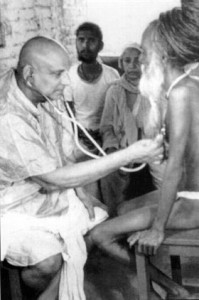
( H.H. Swami Sivananda Saraswati Maharaj )
> SIVANANDA – PRACTICE OF AYURVEDA <
Swami Sivananda Saraswati (September 8, 1887—July 14, 1963) was a Hindu spiritual teacher and a well known proponent of Sivananda Yoga and Vedanta. Sivananda was born Kuppuswami in Pattamadai, in the Tirunelveli district of Tamil Nadu. He studied medicine and served in Malaya as a physician for several years before taking up monasticism. He lived most of the later part of his life near Muni Ki Reti, Rishikesh. He is the founder of The Divine Life Society (1936), Yoga-Vedanta Forest Academy (1948) and author of over 200 books on yoga, vedanta and a variety of other subjects. He established Sivananda Ashram, the location of the headquarters of The Divine Life Society (DLS), on the bank of the Ganges at Shivanandanagar, at a distance of 3 kilometres from Rishikesh.
Sivananda Yoga, the yoga form propagated by him, are now spread in many parts of the world through Sivananda Yoga Vedanta Centres, but these centres are not affiliated with Swami Sivananda’s original ashrams which are run by the Divine Life Society. Read more: > HERE <
Sri Swami Sivanandaji Maharaj was a healer of the body in his Purvashram (before he entered the Holy Order of Sannyasa). He was a born healer, with an extraordinary inborn love to serve humanity; that is why he chose the medical profession as a career. That is why he edited and published a health Journal „Ambrosia“. That is why he went over to Malaya to serve the poor in the plantations there. And, strangely enough, that is why, he renounced the world and embraced the Holy Order of Sannyasa.
He was a healer of the body and the soul. This truth is reflected in the Ashram which he has established in Rishikesh. The huge hospital equipped with modern instruments was set up and the entire Ashram where all are welcome to get themselves healed of their heart’s sores and thoroughly refresh themselves in the divine atmosphere of the holy place.
SERVE, LOVE, GIVE, PURIFY
MEDITATE, REALISE
So Says Sri Swami Sivananda
Saraswati Maharaj
Sri Swamiji wanted that all systems of healing should flourish. He had equal love and admiration for all systems of healing. He wanted that the best of all the systems should be brought out and utilised in the service of Man. He has written a number of books on all aspects of Healing—from the Naturopathic and Allopathic points of view. This one dealing with Ayurveda is a valuable addition to the healer’s armamentarium.
Ayurveda is the Veda or knowledge of Ayus or life. It has been classified as the Fifth Veda.
Ayurveda is a distinct Veda. It is even superior to the other Vedas because it gives life which is the basis of all enjoyments, study, meditation and Yoga Sadhana.
Ayurveda is the science of life. It shows the way to remove diseases, to keep up sound health and attain longevity.
Ayurveda was in vogue in India since very early times. The Ayurvedic and Siddha systems have played a very important and vital part in the sphere of public health. Their popularity is due to their availability, cheapness and efficacy.
Here is a beautiful ideal of Charaka: „Not for self, not for the fulfilment of any earthly desire of gain, but solely for the good of suffering humanity should you treat your patients and so excel all. Those who sell the treatment of disease as merchandise gather the dust and neglect the gold.“
Charaka also says: „A physician who cannot enter into the innermost soul of the patient with the bright light of the lamp of his own knowledge cannot successfully treat any disease.“
India has ever been evolving art after art, science after science, as her contribution to the common heritage of all the nations of the world. Her greatest gift to the world is the gift of the spiritual science of Self-perfection. Next to it we should place this Science of Life, the Ayurveda, as a precious gift to be carefully developed and broadcast to all nations. It is a national duty of every Indian.
Nurse the Sick, Feed the Hungry, Clothe the naked, This is DIVINE LIFE.. …..Swami Sivananda
THE DIVINE LIFE SOCIETY
YOGA, TREE AND OUR UNIVERSE
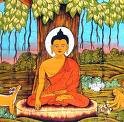
The Originar of Hatha-Yoga
Tree is the highest evolved form in plant kingdom. Man is the highest evolved species in Animal kingdom. Mushrooms are the best fungi visible on this planet. There is commonality of forms among all these highest evolved forms among different type of life-forms -Tree-like structure.Man is a cerebro-spinal being sheathed within a fleshy body. Most evolved form of cell is neuron that mediates consciousness is Tree-like structure. Surprisingly, most powerful thing that mankind achieved viz. atom bomb , produce Tree-like clouds after exploding on the surface.
Tree-like structure in Nature!
One can find out where else do Tree-like structure in nature exist. Pliny, the Younger linked the eruption of Vesuvius eruption in 79 A.D. with Italian umbrella pine. It is now an established scientific fact that the most powerfur process within earth, volcanic plumes that move inside earth is umbrella-shaped with a column & umbrella spinning about vertical axis( Tree-like). The most terrible force on the surface of the earth are the Tornados which are again Tree-like shapes with a column & an umbrella. Tree-like shape is found in other very powerful phenomena like lightening flashes, electric sparks, river delta, snowflakes, coral .
Tree-like structure is characteristics of every visceral system. Biologists trace this form in the mosses, lichens, shrubs, root system, mammalian lung bronchioles, cells of nervous system, veins & arteries forming cardio-vascular system. Wheresoever there are branching system, that invariably culminate in a Tree-like structure.
Tree & Fractal Geometry
In last fortnight, a brilliant paper was published in ‚Advances in Soft Computing“, under the title“Algorithms for Tree-like Structure Generation“ by Anna Romanowska, a neuro-anatomist et al. The team characterised Tree-like structure as that form which bifurcates but do not form any cycles. The team picked up the concepts of fractal geometry & fused with algorithms to create a Recurrent Algorithm. Self-similarity and repetition of sequence( iteration) is generated by a bifurcating cascade. The team concluded that if living system are generated recurrently, complex organic structures like roots, bronchial system in lungs emerge.
Now that an algorithm for Tree-like structure has been generated, it will be feasible in a decade to manufacture on mass scale silicon bronchial/ cardio-vascular/ neural system .
Before the advent of Fractal geometry by Benoit Mandelbrot during 1970s, the question of Tree-like structure had perturbed many a great minds. Hisao Honda of University of Kyoto published a paper on “ Description of the Form of Trees by the parameters of the Tree-like body“ in the Journal of Theoretical Biology, May, 1971. Honda concluded that Tree architecture maximizes flow access. He found stastitical similarity in living & non-living world, among branching in living system & geological & geophysical system.
- Meet Swami SIVANANDA friends, yoga, studies, at facebook <
- Meet Bhagavad Gita friends, yoga, studies at facebook <
- Meet Patanajali friends, yoga, studies at facebook <
- Meet Buddhism, friends, studies, Medicine at facebook <
- Meet Paramahansa Yogananda friends, groups, studies at fb <
- Meet Raja Yoga, Friends, Group, studies at facebook <
- Meet IYENGAR (B.K.S.), Yoga, Friends, Studies, Groups at fb<
- Meet Swami Vivekananda, Yoga, Studies, Friends, Groups at fb<
- Meet Bhagavad Gita, Yoga, Studies, Friends, Groups at fb <
- Meet Ramana Maharshi Groups, Friends, Studies, Fans at fb<
- Meet Hinduism, Groups, Friends at facebook <
- Meet Kashmir Hinduism, Studies, Friends at facebook <
- Meet Shaktism and Devi the Godess at facebook <
- Meet Saundaryalahari: Wave of Bliss by Shankaracharya at fb <
- Meet Arsha Vidya Gurukulam, Studies, Friends, Fans, at fb <
- Meet Advaita Vedanta,Groups,Studies, Vivekananda at fb <
- Meet Yogi Yogendra Nath, Studies about Goraksha at fb <
- Meet Jaya Kula and the three ways of Practicing tantra at fb <
- Meet VASTU, Friends, and Study Groups at facebook <
- Meet Jyotish, Friends, and Study Groups at facebook <
- Meet Sacred Geometry at facebook <
- READ MORE HERE:
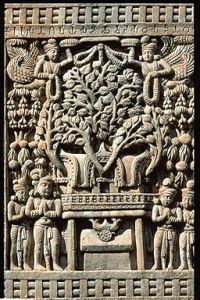
Morphic field & Morphic Resonance!
Tree-form is found in lower kingdom of Animal as well as Fungi. Jelly fishes or the polyp, these are invariably shaped like Trees. The colonies of proliferating marine organism replicate this form. It is interesting that jellyfishes which have no neurons & man with maximum neurons are essentially same in shape. Great Scottish biologist, Sir D’Arcy Thompson wrote in 1917 „On Growth and Form“, to analyse patterns & shapes in nature. His erudite tradition sd being carried by Rupert Sheldrake, a British biologist. He has done extensive work on the concept of morphic field & morphic resonance. By morphic resonance, he explains the influence of Like upon Like by which a connection among similar fields is established. He has shown in his work example of crystallization. It is very difficult to crystallize a new compound for the first time. Once it is done, a morphic field emerge. It is easier next time if someone does elsewhere in the world. There is a cumulative influence & it gets easier & easier to crystallize the compound. There is an accelerated rate of crystallization . Similarly, in learning among rats, this phenomena has been experimentally confirmed. It is difficult for a rat to pass through a maze for the first time. But, once a rat does this, another rat elsewhere does it much easily. And with each learning , there is spontaneous spread of new habits. For Sheldrake, evolutionary spread of new habit is not genetic but depends on a kind of collective memory due to morphic resonance.
This can be easily comprehended in case of human. It was very tough to manufacture clock or VCD or computer. More people are manufacturing, easier it is getting to manufacture. Watches, transistora & VCDs are now cottage industry. Who knows in future, robotics will emerge as similar kind of easily handled industry and there will be garages in every nook & corner of city to repair robots or even remodell robots by neighbourhood mechanic.
Sheldrake further proposes the concept of the „Memory of Nature“. Habits of nature depend on non-local similarity reinforcement. Through morphic resonance, the pattern of activity in self-organizing system are influenced by similar patterns in the past. He brings back the idea of Carl Jung‘ collective unconscious.
Examining Growth of Tree-Form!
I find the concept of morphic resonance appealing. That can explain this frequent recurrnce of similar pattern in nature. If we ponder over the shape of DNA & its future. The fluid around earth’s inner core creates a helical movement and generates magnetic field. The geodynamo of the earth is a self-replicating system that help explain the continuity of magnetism in earth’s core , otherwise it would have dissipated within 20,000 years. Now, the transformatory biological molecule,DNA, is helical as well as self-replicating. Within geo-physical processes, we know that Tree-like plumes are created. Now, this geophysical structure resonates throughout future evolution of biological world. For every plume within, there is a tornado on the surface. This first form of powerful process recurs at the level of the most developed categories at various levels, may it be fungi, or plants or animals or cells. And, that form recurs in even man-made powerful processes like atomic explosions.Upon visualizing this sequence, I can very well predict that the most successful biological robots or most efficient spaceship for planetary travels would have Tree-like architecture. Our Discovery spaceship is a poor materialization of that critical architecture.
Tree & bifurcation!
This Tree-like structure itself is generated by recurrent self-similarity which results due to behaviour of a dynamic system. Now, the chaos theorists have worked out very well that how in a dynamic system , a stage of crisis is set in and at the point , there are two possibilities for the system to transform. Sometimes, the system oscillates between two possibilities as found in certain chemical clocks extensively investigated by Nobal laureate Ilya Prigogine.Most of the times, the branches grow further and then bifurcate. This is iteration of self-similarity that later results into Tree-like structures.
If this kind of bifurcaing iteration is fundamental to our changing Reality which is dynamic, and there is morphic resonance, one can draw the contours of this phenomena of emergence of Tree-like structure at a higher level.
End of biological evolution!
The bifurcation, that determines DNA-replication to cell-division, has finally achieved its destiny in the biological world in the form of Human beings. We are the highest biological form and the biological evolution has now concluded. There is no further scope of biological evolution beyond us.Perfect biological bifurcating branching system has been achieved. Our lungs, our cardio-vascular system, neural system .. everything has emerged as mere consequence of cascading bifurcation. Surprisingly, we have greater number of most evolved cells viz. neurons (200 billions) which themselves replicate own form at macrolevel. The cerebro-spinal system is a magnified neuron. We are the only animal to walk on 2 legs. Penguins do perform but lack other binarities. We have two legs, two hands, two nostrils, two ears, two testicles, two mammary glands, two eyes, two kidneys, two hemispheres in brain, two atrium, two ventricles in heart, two excretory points, two lips, two jaws. Our thinking pattern is also binary. Our categories are in twos- good/bad, high/low,sacred/profasne, self/other… We donot yet understand that this duality in thought is rooted in hemispheric brain or in fractal geometry. There is no more bifurcation & branching possible in bodily architecture of human beings. This is the end-point of biological evolution. Now, mankind is on verge of developing biological robots & higher order machine consciousness therby imbuing consciousness to physical world bypassing the biological evolution. We are becoming the co-creator of the Universe as well as agent to accelerate self-consciousness of physical matter in the universe.
Trees are our cousin!
Now, the issue of Tree-like structure resonates into our collective psyche. Tree is the source of wisdom, healing, nourishment, power. Bible myth has Tree . Newton discovered moodern science sitting under an apple Tree. Buddha discovered non-theistic self-awareness sitting under a peepul Tree. In Tibetan tradition, powerful meditation requires visualizing Tree of lineage with various Gurus on different branches. These kind of visualization has transformative effect on our consciousness. In every culture, Tree occupies a significant position in rituals & mythology. We feel special feeling with Tree. Our romantic mood, our wisdom, contemplative mood, aesthetic mood.. orbit around physical & metaphoric Tree. Tree have power to transmit some kind of healing power to us. Tree are the source of healing body through fruits & herbal medicine . Tree heals our body, mind as well as soul, if any. The processes involved may be a kind of morphic reonance that vitalizes self-similar cardio-vascular, respiratory & neural system.Trees are our morphic cousins. We feel guilty & hurt when trees are cut or when those are under environmental threat.
Future?
One thing is certain. Future robots & spaceships which would be most efficient to survive would have Tree-like architecture. We would have very little to do with blooming of age of nanotechnology, biotechnology & Artificial intelligence. Successful creation of algorithm for Tree-like structure has made it more likely that artificial human organs can be manufactured at industrial level. When death will be conquered after successful download of Memories & large scale diffusion of bionics, We would have enough time to resonate with biological Trees in solitude & steer mankind towards a spiritual evolution as biological evolution from DNA-pathway has reached a dead end!
(Niraj,1.11.2009)
Gross Elements in Ayurveda, Yoga, Buddhism
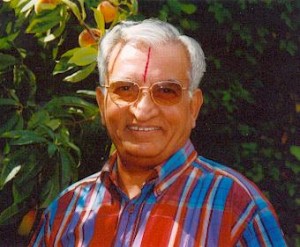
> Principle of Tridoshain Ayurveda <
MahÄ�bhūta is Sanskrit and PÄ�li for „great element.“In Hinduism, the five „great“ or „gross“ elements are ether, air, fire, water and earth. In Buddhism, the „four great elements“ (Pali: cattÄ�ro mahÄ�bhūtÄ�ni) are earth, water, fire and air. Read more: > HERE <
The Principle of Vata, Pitta and Kapha
The Physiology of Âyurveda is the physiology of the all-important trio, Vâta, Pitha and Kapha or Tridosha as they are generally called. Anybody, even faintly acquainted with Ayurveda, must have frequently come across the terms Vâyu, Pitha and Kapha. But very few have any clear idea of what is really meant by the terms. Every grown-up Indian has some vague idea about Vayu, Pitta and Kapha, and the terms are also used in common parlance. But in the majority of instances, the popular conception is quite different from the medical one. We have ample reference in Ayurvedic literature to the properties and different functions of Vatu, Pitta and Kapha, both in their normal and abnormal conditions. But we have no direct evidence by which we can come to a definite conclusion regarding the ultimate nature of these three substances. All that we can do is to make some inference based on reason, by a comparison of the original texts of Charaka, Sushruta and others and supplemented by such evidence as we can get from non-medical sources.
Yet Vâtha, Pitha and Kapha are the three entities on which stands the whole foundation of Ayurveda; we have to deal with them from the beginning to the end. Without their proper knowledge, successful treatment of diseases according to the Ayurvedic System is quite impossible. Before proceeding further, it is necessary that we should know something of the conception of the ancient Hindus regarding the physical world. Charaka and Sushrutha have mainly followed the Nyâya-Vaisheshikha and Sâmkhya-Yoga systems of Philosophy and occasionally the Vedanta view of the five Bhuta.
The nature and Physical Properties of the Tridosha.
The fundamental principle underlying the Ayurvedic System of Medicine is that of the Tridosha. In a nutshell, this Principle may be stated as follows:
There are three Dosha, Vâyu, Pitta and Kapha, which when in equilibrium keep the body sound, but which when vitiated, either singly or in combination, bring about diseases. The method of treatment would therefore be to bring the vitiated Dosha back to normal state, so that the three Dosha are again in equilibrium. We have seen that Âyurveda developed from the four Vedas; it is also regarded as a supplement of the Atharva Veda. But nowhere in the four Vedas can we find any specific mention of these substances.
It is in the Rig Veda only (1.3.6) that we find what may be regarded as the root idea of Vâyu, Pitta and Kapha :
“Tri-no asvinÄ� divyÄ�ni bhesajÄ� trih pÄ�rthivÄ�ni trirudattamadvyaha;
Om�nam samyor-manma k�yasunave tridh�tu sarma vahatam subhaspat�.
Here “tridhÄ�du sarma vahatam” has been explained thus by the commentator SÄ�yana: That is to say that when the three Dhâtu – Vâyu, Pitta and Kapha – remain normal and undisturbed, the body is at ease and there is no disease.
With the advancement of the knowledge, when the science of medicine was systematically studied, Âyurveda as a separate and special subject evolved out of the Vedas. The Principle of Vâyu Pttha and Kapha, was then fully developed and so we find copious reference to these terms in the Mahâ Bhârata and Upanishads.
Draya explained:
Dravya is defined as „that which contains in it action and quality and is a co-existent cause“. (C. S. I. 1.50 ; V. S. I. 1. 15). Substances exist and have qualities. We have two kinds of qualities, those which reside in a plurality of objects and those which are confined to individuals. The former are the general qualities (sâmânya), while the latter are distinguished as permanent (guna) and transitory (karma). Inherence is a special kind of relation. Relations are of two kinds. external like, conjunction (samyoga), or internal like inherence (samavâya). The first is regarded as a quality and the second is made a separate category.
The Vaisheshika believes that a substance is something over, and above the qualities. It is anxious to assert the existence of something which has qualities without being itself a quality, for we predicate qualities of substances and not qualities of qualities. Nor can it be said that we predicate one quality of a group of qualities. But since a substance cannot be conceived apart from qualities, it is defined as possessing qualities.
Qualities and action exist by combination with substance. Without substance, there were no qualities or action. Similarly, genus and species are correlative and are not absolute, except in the case of the highest genus which is Existence (bhâva) and the lowest species which is vishesha or individual characteristics appertaining to and inhering in the external substances. Genus and species, therefore, exist by combination with substances. Without substances, there were no genus and species. Similarly Samavâya or combination is “the intimate connection in the inseparably connected things“, e.g. parts and wholes of substances and their qualities, of action and the seat of action of genus and species and substances in which they reside, and of external substances and their ultimate differences. Without substance, then, there were no combination. Substance or dravya, therefore, is the fundamental reality.
Dravyas are nine in number, viz. the five Bhutas,
- 1. Prthivi (Earth)
- 2. Apah (Water)
- 3. Tejas (Fire)
- 4. Vâyu (Air)
- 5. Âkâsha (Ether
and
- 6. âtman (Soul)
- 7. Manas (Mind)
- 8. Dish or dik (Space) and
- 9. Kâla (Time).
These nine substances are intended to comprise all corporeal (murta) and incorporeal (a-murta) things. Ether, time and space are all-pervading, have the largest dimensions and are the common receptacles of all corporeal things. Soul and mind, Ether, time and space, Air and the ultimate atoms are not ordinarily perceptible, (V. S. VIII. 1.2).
[It must be clearly understood here that whenever we use the terms Earth, Water, Fire, Air and Ether, we use them only to denote the five bhutas and not in the sense of ordinary earth, water, air, fire or ether]
Charaka says that dravyas are of two varieties, – animate and inanimate. Those endowed with the senses are called animate; those devoid of senses are inanimate, (Sendriyam cetanam dravyam, nirindriyam acetanam, C. S. I. 1. 47.)
The Nature Of Citta According To The Yogasutras Of Patanjali
The five Mahâbhutas
The five Mahâbhuta originate from the five Tanmâtra. Of these, the Prthivi helps the other four by being their support. Ap helps the other four by moistening. Tejas helps the others by ripening. Marut helps by drying and Akâsha helps the other four by giving space. Prthivi is possessed of five qualities, – sound, touch, colour, taste and smell. Ap is possessed of four qualities,- sound, touch, colour and taste. Tejas is possessed of three qualities, sound; touch and colour. Vâyu is possessed of two qualities, – sound and touch. Akâsha has only one quality, sound.
We thus get :
Âkâsha/ Aether – (Sound-essence)
Vâyu/ Air – (Sound + touch)
Tejas/ Fire – (Sound + touch + colour)
Ap/ Water – (Sound + touch + colour + taste)
Prthivi/ Earth – (Sound + touch + colour + taste + smell).
Though Earth contains a number of qualities; we yet say that it has smell, on account of the predominance of this quality. If water and other substances besides earth possess smell, it is because particles of Earth are mixed up with them. We cannot think of Earth without smell, though we can so think of air and water. The special quality of Water is taste. Fire has for its special quality luminosity. Air is invisible, though limited in extent and made up of parts. The discrete nature of Air is inferred from the movements in the air, which would not be possible were Air an absolute continuum devoid of parts (V. S. II.1.14). Its existence is inferred from its special quality of touch and it is said to be a substance, since it possesses quality and action.
According to the Vaisheshika, the ultimate constituents of the concrete things of earth, air, fire and water are called paramânu or atoms.
Charaka has pointed out the primary qualities or special physical characters, of the five Bhuta in a different way. He says, „The characteristic of Earth is roughness, that of Water liquidity, of Air expansion, of Fire heat and that of Ether non-resistance. All these qualities are perceived through the sense of touch,“ -„Sparshendriya gocharam“, (C. S, IV. 1,27 ).
Bhutas are not elements
The Bhuta has been translated as ‚element‘. This is misleading. Bhutas are not elements and paramânus are not atoms or molecules in the modern sense of the terms. Modern writers laugh at the idea of calling the earth, water, fire, air and ether elements, ignoring the fact that a Bhuta is just an element, in the chemical sense of a substance that cannot be further analysed. „On referring to any Vaisheshika manual, it will be clear that what is ordinarily known as ‚earth‘, is not regarded by the Vaisheshika to be an ‚element‘ – in the technical sense; if it were so regarded, then alone could the Vaisheshika view be stigmatised as primitive and unscientific. The touch of ‚Earth‘ in its pure state is said to be ’neither hot nor cold’ so also the touch of ‚Air‘ and when asked why the ordinary earth and ordinary air are found to be very far from ’neither hot nor cold‘, the Vaisheshika explains that this is due to earth and air being mixed up with particles of Fire or Water, which make them hot or cold. From this, it is clear that what is regarded as ‚element‘ is not the earth etc., as we know and see them, but as they exist in their pristine and pure state, unmixed with any other substances“. Just as an atom of a chemical element has no free and independent existence, so also the five Bhutas in their pure state are never found in nature. What we find are compounds of the five Bhutas, mixed together in different proportions; that is to say, all gross matter is penta-bhautika.
Psychological explanation of the five Bhutas
The question may be asked, why were only five Bhutas postulated? Now, God has endowed us with only five senses, neither more nor less. The external world can only be apprehended by us through these five senses or Indriya. There is no other source which can give any information about matter which constitutes the physical world. For one particular lndriya, there is only one particular sense-object. The srotarerdriya or the sense of hearing can appreciate only the quality of sound. Sound, touch, colour, taste and smell are the five sense-objects corresponding to the five senses. These are gunas, and as such cannot exist independently by themselves, but must have some receptacle. In this way, we get five receptacles,- the five Bhutas.
What, for example, is the ‚atom‘ of Earth, but an ultimate material substratum of odour. On the other hand, let us take the case of the coloured gas Chlorine. It can be felt, smelt, tasted and seen. We are cognizant of its existence by at least four different sensory impressions; therefore it is not an element in the Vaisheshika sense of the term; it must be composed of at least four different Bhuta. The Hindu classification of matter into five Bhuta is, therefore, not at all absurd, as is supposed by many scientists who have an altogether different viewpoint.
According to Dr. Ganganath Jha, what the Vaisheshika means by saying that there are five Bhuta, is that there are five states of matter, viz., solid (Earth), liquid (Water), gaseous (Air), luminous (Fire) and etheric (Akâsha). It is better, however, to regard them as the Ashrayas or repositories of the five qualities,. viz. of smell, etc.
The confusion has been introduced by denoting the Bkutas by terms which are also used with reference to external objects of matter, such as earth, etc. But, as Hoffding says, „because language was developed under the influence of attention directed to the external world, we find that expressions for mental phenomena were originally taken from the material world. The inner „World behind is denoted by symbols borrowed from the „outer world of space“.
Contemplation of the elements (dhatu, mahabhuta) as a meditation method taught by the Buddha.
Hindu Medicine and the Vedas:
There is no doubt that the germ of Hindu medicine was laid in the Vedas. Because in all the four Vedas, – Rig, Yajur, Sâma and Athravana, – we find ample reference to medicine, drugs, methods of treatment and descriptions of the different parts and organs of the human body.
For example, reference is made to Dhanvantari in R.V IX. 112. In R.V. 1.117. 13 and V.74.5, we find that Chyavana was rejuvenated by the Ashvini Kumâras. ln 1. 23. 19, the medicinal properties of water are described. Reference is made to phthisis in R. V. X. 163 and to the organs of the body in R. V. III. 36.8, III. 50. 6, VI. 53. 8, VIII. 1. 26, X. 1. 84, X. 163 and X. 186. Similarly in the Sâma Veda II. 10. 70. 184 and in the White Yajur Veda XII.74. 75 and the 16 hymns that follow, we have reference to the medicinal properties of drugs.
But it is the Atharvana Veda which deals more fully with medicine. Here we have reference not only to mineral and vegetable drugs but also the causes of diseases (A. V. I. 23, 24, 36 ). „This work in its tenth book contains“, as Dr. Hroernle notes, „a hymn (the second) on the creation of man, in which the several parts of the skeleton are carefully and orderly enumerated in, striking agreement more specially with the system of Atreya as contained in Charaka’s Compendium“.
It is for this reason that the Ayurveda is generally included in the Atharvana Veda. This is also distinctly indicated by both Charaka and Sushruta. Sushruta (1. 1) calls it the Upânga of Atharvana Veda; and in Charaka Samhiaf (1. 30), we find that Atreya’s advice to his pupils was to have faith in the Atharvana Veda, because the latter deals with the treatment of diseases in the form of religious rites, sacrifices, oblations, expiation, fasts, the chanting of hymns, etc.
If we take the time of the Vedas to be 2000 B. C., we see that as early as this, the practice of medicine was in a very crude form. Nowhere in the four Vedas, can we find any mention of the term ‚Ayurveda‘. So we may take it that when later on the medical side of the Vedas was more fully and systematically developed, it formed a separate subject by itself and came to be known as Ayurveda.
- Dein Ayurveda Net:
- Samkhya Philosophie im Yoga
- Tattvas im Ayurveda und Yoga
- Die Veden, ein Überblick, Overview
- Arthavaveda
- Yoga in Buddhism
- Krishnamachar B.K.S. Iyengar, Bellur School, Patanjali Temple
- www.patanjaliyogafoundation.com
- yogena chittasya padena vacham malam sarirasya cha vaidyakena | yopakaroti tam pravaram muninam patanjalim pranajaliranato’smi || Let us bow the noblest of sages Patanjali, who gave Yoga for serenity of the mind, Sanskrit grammar for purity of speech and Ayurvedic medicine for the perfection of health.
- Meet all Ayurveda Groups, Friends, Studies at facebook <
- Meet Lord Dhanvantri at facebook <
Global Warming, Year of Biodiversity 2010
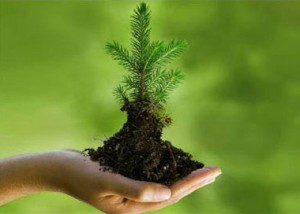
> ÖBf – 800 PROJEKTE DER ARTENVIELFALT <
Global warming is the increase in the average temperature of Earth’s near-surface air and oceans since the mid-20th century and its projected continuation. Global surface temperature increased 0.74 ± 0.18 °C (1.33 ± 0.32 °F) between the start and the end of the 20th century.[2][A] The Intergovernmental Panel on Climate Change (IPCC) concludes that most of the observed temperature increase since the middle of the 20th century was caused by increasing concentrations of greenhouse gases resulting from human activity such as fossil fuel burning and deforestation. Read More: > HERE <
Separating Global Warming from Global Pollution
By David Frawley (Vamadeva Shastri)
The pollution of our natural environment, the decline of the quality of our air, water and soils, the destruction of numerous ecosystems and consequent loss of species is an obvious fact that can be easily documented. We usually don’t have to go much further than our own immediate environment or nearby countryside to see the tell tale signs of this, whether it is the decline of our forests, the garbage in our parks and streets, or the dirty air and noise of our cities. One might have to travel further in the United States than in India to do this, but it doesn’t take much effort if one wants to make it.
We can also look to our childhood memories or talk to our parents about how much nicer our natural environment used to be in terms of the plants, animals and atmosphere in what are now rapidly becoming the good old days, at least for Mother Earth. There may be some areas left that are pristine and much that is now being protected, but most of the forests have been cut and even the normal weather vagaries can cause considerable damage to the altered or depleted landscape, climate changes notwithstanding.
Yet the ecological realm today is dominated by another debate, which is that of global warming. The question is whether this environmental degradation through global pollution may cause global warming or possibly global cooling or neither. However, we should note that global warming is a separate issue and much more difficult to prove or disprove than global pollution.
Global warming has become, it appears by the amount of press and political gatherings, like that at Copenhagen recently, the main issue and the primary global environmental problem, causing passion and vehemence on both sides. The more obvious problem of global pollution and the more immediacy needed to deal with its effects can unfortunately be obscured by this debate. Even if global warming may not be occurring or may not be so rapid, global pollution is staring us in the face and damaging our own lives with an impact on to future generations.
More in ‚David Frawley‘: FOLKS, Full Article
- Linguistics and Civilization
- Vedic Origins of the Europeans: The Children of Danu
- Yoga: From Patanjali Back to Hiranyagarbha
- The Sacred Activism
Co-operation on Health and Biodiversity
Welcome to the website of the COHAB Initiative (Co-Operation On Health And Biodiversity), an international programme of work on human well-being and sustainable development.
The COHAB Initiative works to establish an international, inter-disciplinary framework for dialogue and partnership, supporting activities for community health, international development and biodiversity conservation. The Initiative, through a global network of COHAB Partners, works towards the implementation of the United Nations Convention on Biological Diversity and the Millennium Development Goals. It provides a global forum for all stakeholders to share experiences, discuss needs and opportunities, build capacities and develop new partnerships.
Healthy Planet, Healthy People
Biodiversity, through the provision of ecosystem goods and services, provides the basis for all life on earth. It supports all of our economic and social development, and is vital to our health and well-being. Species of animals and plants have always been important as sources of food, fuels, medicines, clothing and building materials, while ecosystems provide and maintain supplies of clean water, healthy soil and clean air. However, this is frequently taken for granted in an increasingly developed and globalised world.
Truly sustainable development must incorporate all areas of human activity and our interactions with the environment, and therefore requires that social, economic, public health and environmental needs be resolved holistically. In order to fully achieve sustainable progress – whether at local, national, regional or international levels – policy makers, scientists, stakeholders and the wider public must work together.
Die Österreichischen Bundesforste (ÖBf) starten mit über 800 Natur- und Umweltschutzprojekten in das Internationale Jahr der Biodiversität 2010. „Jedes gesunde Ökosystem, jeder gesunde Wald braucht Artenvielfalt“, erklärt Georg Erlacher, Vorstandssprecher der Österreichischen Bundesforste. „Daher ist es unser Ziel, mit naturnaher Waldwirtschaft, der Erhaltung von Schutzgebieten und zahlreichen Einzelmaßnahmen Vielfalt zu sichern und den Verlust von Arten und Lebensräumen zu stoppen.“ Die Bandbreite der Maßnahmen reicht von besonderer Rücksichtnahme auf sensible Brutgebiete über die Ausweisung von Schutz- und Schongebieten bis hin zu großflächigen Moorrenaturierungen. Als erster Forstbetrieb Europas beteiligten sich die Bundesforste am internationalen Biodiversitäts-programm „Countdown 2010“ und haben darauf aufbauend ein eigenes 5jähriges Schutzprogramm zusätzlich zu den bestehenden Maßnahmen entwickelt.
> Meet COHAB Intitative, friends, studies at fb <
> Meet Biodiversity Friends, Groups and Studies at facebook <
> Meet Naturfreunde Groups, Friends, Fans at facebook <
Mahayogi, Yogacharya, Guru Gorakhnath
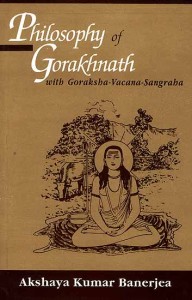
MAHAYOGI YOGACHARYA GURU GORKHNAHT JI AADESH AADESH .
BY MR . VISHAWAJEET SING JI
> HATHA YOGA AND THE MEANING OF TANTRA <
AADESH AADESH ,
MAHAYOGI ,YOGACHARYA ,GURU GORKH NATH JI
However, great Yogis such as Gorakshanath are following the system of Sadanga Yoga which has been stated by him in his book Goraksha Paddhati 1.7. This System avoids Yamaand Niyama. The justification given by those Yogis is that if you obtain mastery in meditation, your whole lifestyle gets changed in such a way, that you automatically start following the Yama and Niyamawhich are the necessary rules and individual rules of conduct respectively. These six aspects of Yoga are:
- Physical Postures
- Pranayama
- Pratyahara
- Dharana
- Dhyana
- Samadhi
2. According to the Nath Cult it is most important that the aspirant should purify his body completely. This has been stated in detail in Gheranda Samhita l.10-11-12. This is a total purification of all important and vital organs of the body such as stomach, small intestines, large intestines, nasal passage, food pipe, eyes, cars, throat, etc. After this the cult says that the aspirant is in a position to undertake all the steps of Yoga. In Patanjali’s Yoga Sutras this preparation of initial background is not mentioned.
3. The next step (in other Yoga systems) is the learning of physical postures. However, after learning all the important postures, the aspirant has to practise the most essential posture viz. Siddhasana or Vajrasana. For all the future Sadhanas this is considered to be the basic and important posture. The detailed description of this posture is given by Jnaneshvara in his sixth chapter of Jnaneshvari and also by a number of books of Nath Cult. They say that this posture is a must for all the aspirants. However, Patanjali says that you can sit in any convenient posture you like. Hence he gives the Sutra „Sthira-sukham asanam.“
4. The importance of a Guru or Master is maximum in Nath cult. Their every book or Shastra starts by remembering or bowing with great reverence and respect to the Guru Adinath or Shiva or Shankara. Jnaneshvari also starts like this by saying „Om Namoji Adya.“ This importance is not given to Guru in Patanjala Yoga Darshana.
5. The Nath cult says that the human body consists of certain most essential centres or vital points and voids (Akasha). (8) Every aspirant has to know and understand these things. They say that one who is not aware of these essential centres is not a Yogi. They are six Chakras, sixteen vital points, two Laksyas (concentration points), five voids, all situated within the human body. Such type of discussion is not found in Patanjala Yoga Darshana.
6. Nath cult says that the human body is just like a beautiful house which is having nine doors. It is formed out of five essential elements and each element is having its own deity. The nine openings are two eyes, two nostrils, two ear holes, mouth, excreta outlet, and sex organ. The deity of Earth is Brahma, of water is Vishnu, of fire is Rudra, of air is Ishvaraand of space is Sadashiva. Every aspirant has to understand these things. In Patanjala Sutras we do not find this.
7. The Nath Panth, in their various books as mentioned above, gives a detailed description of the seven chakras, their exact location in the body, their properties and functions etc. Jnaneshvara has not given the description of these chakras for the reason that he wanted to restrict his interpretation to the verses of Bhagavad-Gita. At the base of the spinal cord and at the centre of the line which connects sex organ and the excreta outlet is situated the first chakra which is known as Muladhara Chakra. Slightly above the sex centre and below the naval centre the second chakra is situated which is known as Svadhisthana Chakra. The third is situated near the naval centre and is called Manipura. The fourth one is situated near the heart centre and is known as Anahata Chakra. The fifth is situated at the throat centre and is known as Visuddha Chakra. It must be noted that all these chakras are situated in the Shushumna Nadi which passes through the spinal cord, which again passes through Vertebral Column. These are extremely subtle points and may not be structural and cannot be located by any sophisticated instrument available. These were actually ‚observed‘ and seen by the great Rishis in the stage of Samadhi. Here come the limitations of modern science. The sixth chakra is situated on the forehead and between the centre of the two eyebrows. This is known as Ajna Chakra. The seventh and the last chakra is situated in the centre of the brain in its uppermost portion. Patanjali does not mention any such thing in his Yoga Sutras.
8. According to Nath Cult there are 72.000 nerves in the body of human beings. Out of these ten Nadis are important. Out of these three are most important. They are known as Ida, Pingula and Shushumna. Ida is known as Chandra Nadi and is passing through the left side of the vertebral column. Pingula is known as Surya Nadi and is passing through the right side of the vertebral column. Shushumna Nadi is passing through the spinal cord and is known as Agni Nadi. Patanjali’s Yoga Sutras do not mention all this. He does mention a few Nadis like Kurma Nadi. But the detailed description is absent.
9. The concept of Prana has been studied in maximum details in Nath Cult. They say that in the human body there are ten different types of air or Vayus , which are known as Prana, Apana, Samana, Udana, Vyana, Naga, Kurma, Krikala, Devadatta and Dhananjaya. Each one is situated in a specific part of the body. Each one is having specific purpose and function in the body. When we take the air inside our body, it gets bifurcated into ten branches. This is just like a stream of water which starts from the Himalayan Mountains and gets bifurcated into several branches and each branch becomes a river and is given a separate name. Present medical science is not in a position to locate these ten different types of airs. However, our ancient Yogis have actually ’seen‘ these different streams of air inside our body. This type of description is not found in Patanjala Sutras.
10. When we breathe in there is a subtle sound which is known as ‚So‘ and when we breathe out there is a subtle sound which is known as ‚Ham‘. Everyone can experience this with slight practice. This sound of ‚Soham‘ is continuously going on with every breathing. In a period of one day, that is twenty-four hours, we take 21.600 breathings. That means this type of sound which is known as Mantra, is being continued in our body for that many number of times (21.600). If the aspirant observes this mentally and consciously, this becomes a great Sadhana. This Sadhana is being given very great importance in the Nath Cult. This is not found in Patanjala Yoga Sutras (PYS).
11. The most important aspect of the Yoga Sadhana of Jnaneshvara is the activation of the Kundalini Shakti. This is a Tantric Sadhana of the Nath Cult. Jnaneshvara has given a detailed account of this process in his sixth chapter. This is a practical application of the philosophy of Nath Panth. They say that the whole universe is created out of the energy of Shiva or Mahashiva or Adinatha. They call it Shakti or cosmic energy. This energy is occupying the whole universe. The smallest portion of this energy is known as Kundalini, and the energy which is present in the entire universe is known as Maha Kundalini. This energy is present in human beings in potential form (Supta Shakti). The Yogis who have experienced this energy, say that this is like a serpent and is situated at the end of the Shushumna Nadi in a coiled form, in three and a half coils, position. This also is in line with their philosophy which says „Bramhandi te Pindi“. This means that whatever exists in the universe also exists in the human being in the subtle form. Nath Cult and their great masters like Gorakshanath have devised various ways and means to activate this energy. Saint Jnaneshvara has described one method of activating this energy. This method has been stated in almost all the books of Hatha Yoga and Natha Panth and some Upanishads. The detailed description is available in the sixth chapter of Jnaneshvari.
This energy can also be activated by Mantra Yoga, Laya Yoga and Bhakti Yoga. That is why we find in Jnaneshvari all these systems of Upasana.
The ultimate stage of realisation or Moksha as per this colt is the union of Shakti with Shiva. Hence the aspirant initiated in this cult has to activate this energy and allow this energy to go through all the six chakras gradually. The place of Shiva is considered to be in the last chakra which is known as Sahasrara. In the ultimate stage, Sadhaka has to transfer this energy to this last chakra. This is supposed to be the point of union of Shakti with Shiva. One who is successful in this process, is supposed to be a great Yogi. A number of spiritual powers known as siddhis are at his disposal in that stage. A number of examples are available in the ancient Shastras about the Yogis, who were successful in obtaining this highest stage. Jnaneshvara had experienced the above union with Shiva and hence he is known as Maha Yogi. In PYS we do not find anything about Kundalini Shakti.
12. In Nath cult there is a great importance of a Gun or Master. He is given the same importance as is given to their ultimate Guru Adinath. That is why Jnaneshvara is giving maximum importance to his Guru Nivrittinath and is mentioning his name in Jnaneshvari at a number of places. Not only that, he gives the entire credit of writing this book to Nivrittinath. Their philosophy says that the aspirant can get the ultimate experience of truth or Shiva only with the continuous guidance of Guru or the Master. We find that every book of Nath Panth starts after bowing to Guru.
13. In this cult we find a mystic and esoteric act of the transfer of spiritual energy from the master to the initiated aspirant and the act is known as Shaktipata. With the tremendous powers of the master, he can activate the Kundalini energy of the disciple. This transfer, he can do by touching a specific part of his body or simply by looking at him. This transfer of energy can be done on the aspirant who is at a great distance from the master. This is a peculiar mystical act. After the transfer of energy, the aspirant experiences a number of supernatural things, a tremendous flow (of liquid) light, etc. However, those scholars who are really anxious, should go through the book Awakening of Kundalini written by Pandit Gopi Krishna, who had undergone all these experiences before about twenty-five years in Kashmir. The concept of Shaktipata is not found in PYS.
14. This cult gives a great importance to the practice of certain physical postures known as Mudras. They are useful in meditation and also in the activation of Kundalini energy and the six chakras. Hence every aspirant has to learn these Mudras. The ancient texts say that such Mudras arc twenty-five. Out of these ten are most important. With the practice of Mudras the aspirant is in a position to get rid of any and every disease and can acquire a number of supernatural powers. Because of these multiple advantages, the aspirant is taught these postures and afterhe achieves this experience, he is taught Pranayama. Mudras arc nowhere mentioned in PYS.
15. There is a difference between the Dhyana-meditation of Patanjali and Jnaneshvara. Patanjali gives the definition of Dhyana as per Sutra No. III.1 and III 2 which are as under. The aspirant has to concentrate on specific or vital part of the body or on some external point. This process is known as Dharana. When the aspirant gets success in the concentration on that particular point, for a sufficiently long time, it becomes a Dhyana. For the concentration on that particular point, the aspirant has to use his mind. However, in Kundalini Yoga, the aspirant has not to use his mind at all. He has to practise Kumbhaka, wherein the function of mind totally stops. Instead of concentrating on any particular point, the aspirant has to activate the Kundalini energy. This is a much superior way. This opinion has been confirmed by Sir John Woodroffe, in his book The Serpent Power on page No. 314 and 315 of the eleventh edition, which the learned scholars and philosophers can refer to any time.
16. Patanjali gives a broad division of Samadhi, which is termed as SamprajnataSamadhi and Asamprajnata Samadhi. However, the stage of Samadhi has been studied in details by the Nath cult and which is followedby Jnaneshvara in toto. Nath cult has categorised Samadhi in six types which are known as I ) Dhyana Yoga Samadhi, 2) Nada Yoga Samadhi, 3) Rasananda Yoga Samadhi, 4) Laya yoga Samadhi, 5) Bhakti Yoga Samadhi, and 6) Raja Yoga Samadhi. How each Samadhi can be experienced is also discussed in details. Scholars and philosophers can refer chapter seven of Gheranda Samhita which gives the entire description.
To conclude, I would like to state that both these systems of Yoga are different. The reason is obvious. Their philosophical base is altogether different. That is why the Yoga of Nath Panth accommodates Hatha Yoga, Kundalini Yoga, Mantra Yoga, and Bhakti Yoga. This Yoga Philosophy is therefore multi-dimensional. Besides the results here are very fast. This has been promised by Gorakshanath in his book. However, it is advisable that the practices of this Yoga should be undertaken under an able and experienced master.
To end the paper, I would like to quote the verse No. IV.114 from Hatha Yoga Pradipika. It says that till you are not in a position to activate the Kundalini energy, till you are not in a position to have perfect control over your pranic force, till you are not in a position to clear the path of Shushumna Nadi, all your knowledge is external, futile and full of ego. It is only an exercise of talking and nothing else. Hence he says that this is a process which has to be experienced only.
References
- Jnanesvari by Sakhare Maharaj.
- Goraksa-paddhati by Gorakshanath.
- Gheranda Samhita – Commentary by Shree Swamiji Maharaj.
- Hatha-yoga-Pradipika by Shree Swatmarama Yogi
- Patanjala Yoga (Sutra) Pradipa by Swami Omananda Tirtha.
- Patanjala Yoga Darsana by K.K. Kolhatkar
- Yoga Yajnavalkya
- Siddha-Siddhanta-Paddhati by Gorakshanath
- Shiva-Samhita – Commentary by Dr. K.R. Joshi
Dein Ayurveda Net, > svadhyaya < , Articles:
